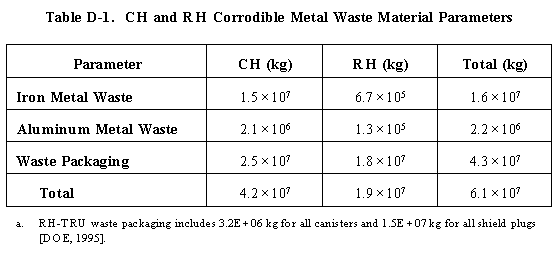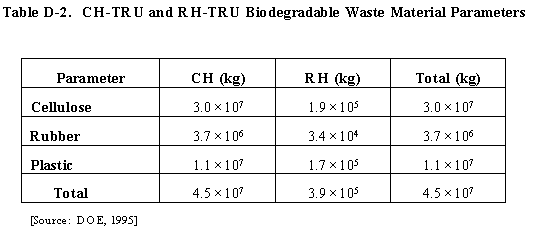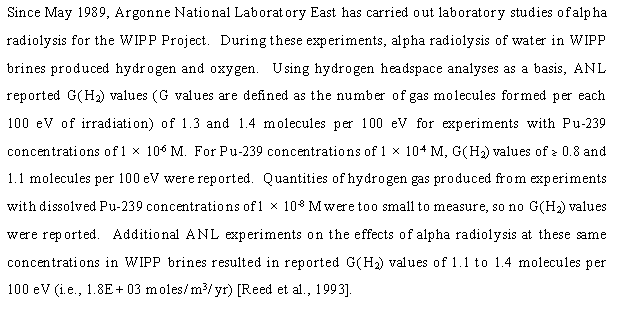Appendix D - GAS GENERATION MECHANISMS
The three primary gas generation mechanisms expected to be involved in the degradation of TRU wastes over time in the WIPP repository include:
- Metal corrosion (of iron and aluminum alloys);
- Microbial degradation (of cellulose, and perhaps rubber and plastic); and
- Alpha radiolysis (of water in the waste and brine, and cellulose, rubber, and plastic).
From the standpoint of gas generation for the WIPP repository, the most important mechanisms are (1) corrosion (specifically anoxic corrosion) of steels and other iron alloys, as well as aluminum alloys; and (2) microbial degradation (specifically anaerobic microbial degradation) of cellulosse, and perhaps rubber and plastic. Radiolysis studies indicate that gas generation rates from alpha radiolysis are not as significant as compared to the rates expected from anoxic corrosion and anaerobic microbial degradation [Brush, 1995].
Corrosion
Corrosion of metals in the WIPP disposal rooms may produce significant amounts of gas as well as consume significant amounts of water. The quantity of gas production, or water consumption, is directly dependent on two major factors: (1) the amount of water present in the waste at the time of emplacement and/or the amount of brine that enters the repository after closure and (2) the quantity of corrodible metals present in the waste. The WIPP WAC limits the amount of residual liquids that can be present in TRU waste to 1 volume percent of the internal container or an aggregate amount of residual liquid <1 volume percent of the external container [DOE, 1991]. As shown in Table D-1, there are substantial quantities of corrodible metals expected in the WIPP inventory. Table D-1 shows the distribution of these corrodible metals for both the CH-TRU and RH-TRU waste inventories.

There are two corrosion mechanisms that can occur in the WIPP disposal rooms, oxic corrosion and anoxic corrosion. Oxic corrosion of the corrodible metals in the waste inventory will consume the oxygen in the disposal rooms following emplacement of the WIPP seal systems. After the depletion of oxygen initially present, anoxic corrosion of these same materials will dominate; this will produce hydrogen and consume water at rates that will depend on the amount of brine present [Brush, 1995]. These two mechanisms are described in detail below.
Oxic corrosion is expected to have a minimal effect on the gas and water content of the WIPP repository. This is due primarily to the sealed nature of the repository after closure and the limited ability for additional oxygen to be generated. Based on estimates of the quantity of steel in the CH-TRU waste drums to be emplaced in the WIPP repository, oxygen trapped in the mine air at the time of closure will only be sufficient to oxidize about 0.4 to 1.1 percent of the drums, depending on the initial void volume assumed [Brush and Anderson, 1989]. With the inclusion of RH-TRU corrodible metals from the waste and waste packages, the rate of oxygen depletion will increase. The amount of oxygen consumed will remain the same. The importance of oxic corrosion will also depend on the rate of oxygen production from alpha radiolysis of the water in the waste and brine [Brush, 1995]. The radiolytic oxygen production rate depends on the quantity of brine, the initial water in the waste, and the concentrations of alpha-emitting radionuclides in the TRU waste. Estimates of the available oxygen initially present in the disposal rooms after closure indicate that the duration of oxic corrosion of steels and iron metals will be relatively short and of low consequence to the production of gas [Lappin et al., 1989]. Therefore, oxic corrosion is not considered significant in the comparison of CH-TRU and RH-TRU waste.
Anoxic corrosion of iron and aluminum alloys in the TRU waste has the potential to consume water and produce hydrogen, assuming several repository conditions are applicable. These conditions include (1) sufficient water is present in the waste at the time of emplacement or sufficient quantities of brine enter the WIPP disposal rooms after closure; (2) major microbial degradation and concomitant passivation does not occur; and (3) if major microbial degradation and concomitant passivation does occur, consumption of carbon dioxide or hydrogen sulfide depassivates the iron metals and steels present in the waste. However, if sufficient brine is available, microbial degradation could produce carbon dioxide and/or hydrogen sulfide (in addition to other gases), which could passivate steel and other iron-base alloys and thus prevent additional hydrogen production and water consumption [Brush, 1995].
Laboratory studies of anoxic corrosion have been carried out for the WIPP Project at Pacific Northwest Laboratories (PNL) since November 1989. PNL conducted various experiments for periods of 3 to 24 months at low pressures (about 5 to 20 atm) and high pressures (about 36 to 73 atm) on iron metals similar to those expected to be emplaced in WIPP. Low-pressure experiments were conducted to determine the effects of humid and inundated conditions, the composition of the gaseous phase, and different steel alloys on the hydrogen production and corrosion rates. High-pressure experiments were conducted to determine the effects of pressure, gaseous-phase composition, and different steel alloy on the corrosion rates. As a result of these experiments, PNL concluded that anoxic corrosion of iron alloys present in TRU waste and in contact with brines at a neutral pH and at low pressure will occur at a rate of 0.99 micrometers of steel per year and produce hydrogen [Telander and Westerman, 1993].
Estimates for anoxic corrosion rates of steels and other iron alloys under inundated conditions with initially pure nitrogen at low pressures (about 10 to 15 atm) have been used for WIPP performance assessment calculations. Because anoxic corrosion is a significant gas-generating mechanism expected to occur in the WIPP repository, gas generation rates for generation of hydrogen for both CH-TRU and RH-TRU waste are represented by minimum (0), maximum (20), and best-estimate values [1](0.1 moles of hydrogen (micrometers steel/year)) [Brush, 1995]. These gas generation rates for both CH-TRU and RH-TRU wastes are identical because there are no significant differences between these waste forms that would directly influence corrosion. The comparison of the rates for CH-TRU and RH-TRU wastes indicates that the inclusion of RH-TRU iron alloys in the repository could result in an increase from 0 to 31 percent, depending on the quantity of brine available and the occurrence of passivation [DOE, 1995].
Based on the quantities of aluminum alloys expected to be emplaced in the WIPP repository (see Table D-1), their corrosion is included when comparing CH-TRU and RH-TRU waste. The gas generation rates for both CH-TRU and RH-TRU aluminum waste is identical because there are no distinguishing attributes of this waste form that would directly influence corrosion. The inclusion of RH-TRU aluminum alloys in the repository will result in a minimal increase in the hydrogen content of the repository because of the limited amount of aluminum present in the RH-TRU waste. RH-TRU aluminum alloy waste will increase the total corrodible metal content of the repository by 0.2 percent [DOE, 1995]. RH-TRU aluminum waste could increase the amount of gas generated from zero to 0.2 percent.
In conclusion, the quantities of gas generated from iron and aluminum alloys expected in the WIPP repository can be significant, assuming inundated repository conditions. However, for anoxic corrosion the amount of gas produced will not only be dependent on the quantity of corrodible metals available, but could be limited by the amount of brine to enter the repository. The inclusion of RH-TRU waste metals, together with waste packaging and the shield plugs, will increase the total corrodible metal inventory by about 31 percent by mass. Under the current baseline, RH-TRU waste emplacement requires the use of a shield plug, which accounts for approximately 25 percent of all corrodible metals. However, DOE is currently evaluating alternative plug designs that would generate less or no gas. The comparison of CH-TRU and RH-TRU waste metals (i.e., all corrodible metals, excluding the RH shield plug) identifies a minimal increase in the potential amount of gas to be contributed from the RH-TRU metals.
Microbial Degradation
The quantities of cellulose, rubber, and plastic present in TRU waste make microbial degradation of these materials another important issue in the comparison of CH-TRU and RH-TRU wastes. Table D-2 shows the comparison of CH and RH materials that will potentially undergo microbial degradation. The most important requirements associated with this mechanism are that viable microorganisms be present and that they can survive for a significant fraction of the 10,000-year period of performance of the repository. Other important requirements include the presence of sufficient brine or water vapor for diffusive transport from the waste or rock in which the microbes occur, along with the presence and availability of sufficient electron acceptors and nutrients (especially nitrogen and phosphorus) [Brush, 1995; Brush, 1990].
Microorganisms are expected to enter the repository from several sources, including (1) association with the CH-TRU and RH-TRU waste during emplacement; (2) the surface environment, through the mine ventilation systems during operation or human intrusion; and (3) resident populations of halotolerant and halophilic bacteria in the salt crystal and brine formations. Estimates of brine inflow indicate that the small amounts of brine necessary for microbial degradation to occur will initially be present in the WIPP disposal rooms [Sandia WIPP Project, 1992]. Electron acceptors may be present in the waste or the surrounding formation in the form of nitrate ions and sulfate ions (carbon dioxide or organic acids could also serve as electron acceptors). If sufficient electron acceptors are present, they will require container rupture and the presence of brine for diffusive transport to the waste containing cellulose, rubber, and plastic. Container rupture and the presence of brine will also be necessary for transport of nutrients that may be present in the CH-TRU and RH-TRU waste [Brush, 1995]. Alpha radiation from the CH-TRU and RH-TRU waste is expected to have a very minimal effect on microbial degradation [Barnhart et al., 1980; Francis and Gillow, 1994]. Both aerobic and anaerobic microbial degradation are expected to occur in the WIPP repository; these are described in detail below.

Aerobic microbial degradation (respiration using molecular oxygen as the electron acceptor) will have a minor, indirect effect on the gas and water content of the WIPP repository. This conclusion is based on the quantity of oxygen initially present in the mine air trapped in the WIPP repository after closure [Brush, 1995].
After depletion of oxygen in the WIPP repository, anaerobic microbial degradation (respiration using nitrate ions, manganese (IV) oxides and hydroxides, iron (III) oxides and hydroxides, sulfate ions, organic acids, or carbon dioxide as the electron acceptor) will begin. From the standpoint of the gas and water contents of the WIPP repository, anaerobic microbial degradation will be much more prominent than aerobic microbial degradation because there will be much more nitrate and sulfate ions and carbon dioxide present than oxygen [Brush, 1995 and 1990]. Assuming inundated conditions, anaerobic microbial degradation in the WIPP disposal rooms could generate significant gas. However, because microbial transport to the organic waste materials is brine dependent and because of the small quantity of organic waste from the RH-TRU waste inventory (1 percent by mass [DOE, 1995]), gas generation from the inclusion of RH-TRU organic wastes will be minimal.
Brookhaven National Laboratory (BNL) has conducted long-term inundated experiments on aerobic and anaerobic microbial gas generation for the WIPP Project since May 1991. The gas generation rates observed in these experiments have been used to develop the range used by SNL in the 1991 and 1992 WIPP performance assessment calculations. Estimated rates for microbial degradation of cellulose, rubber, and plastic for gas generation under inundated conditions range from a minimum of 0 to a maximum of 0.5 moles of gas per kilogram of organic material per year, with 0.1 as the [2] best estimate [Brush, 1995]. These gas generation rates for both CH-TRU and RH-TRU wastes are identical because there are no distinguishing attributes of these waste forms that would directly influence microbial degradation. The comparison of these two waste types indicates that the inclusion of RH cellulose, rubber, and plastic in the repository could result in a minimal increase on the gas content of the repository from 0 to about 1 percent. The RH cellulose, rubber, and plastic will increase the total organic waste content of the repository by approximately 1 percent by mass.
Radiolysis
Radiolysis by alpha particles will not be a significant mechanism for gas generation in the WIPP repository [Brush, 1995]. Radiolysis of water in the waste and brine in the WIPP repository will consume water and produce hydrogen and perhaps limited oxygen. A variety of gases can also be produced by the alpha radiolysis of cellulose, rubber, and plastic in the waste.

It can be concluded from these experiments that alpha radiolysis of WIPP brines will produce hydrogen and oxygen at rates much lower than the expected gas production rates for anoxic corrosion and anaerobic microbial degradation [Brush et al., 1993]. Additional evaluation by SNL suggests that alpha radiolysis of cellulose, rubber, and plastic will be minimal from the standpoint of long-term gas production in the WIPP repository [Brush, 1995]. Estimates for the production of gas from alpha radiolysis that will occur in the WIPP disposal rooms indicate that alpha radiolysis will be only a minor contributor to gas generation. In consideration of the CH-TRU and RH-TRU waste inventory, the amount of gas generated from alpha radiolysis is anticipated to be minimal.
References
Barnhart, B. J., E. W. Campbell, E. Martinez, D. E. Caldwell, and R. Hallett, 1980, Potential Microbial Impact on Transuranic Wastes Under Conditions Expected in the Waste Isolation Pilot Plant (WIPP), Annual Report, October 1, 1978 September 30, 1979, LA-8297-PR, Los Alamos Scientific Laboratory, Los Alamos, New Mexico.
Brush, L. H., 1990, Test Plan for Laboratory and Modeling Studies of Repository and Radionuclide Chemistry for the Waste Isolation Pilot Plant, SAND90-0266, Sandia National Laboratories, Albuquerque, New Mexico.>/p>
Brush, L. H., 1995, Systems Prioritization Method Iteration 2, Baseline Position Paper: Gas Generation in the Waste Isolation Pilot Plant, Sandia National Laboratories, March 17, 1995.
Brush, L. H., and D. R. Anderson, 1989, Potential Effects of Chemical Reactions on WIPP Gas Water Budgets, Systems Analysis, Long-Term Radionuclide Transport, and Dose Assessments, Waste Isolation Pilot Plant (WIPP), Southeastern New Mexico, March 1989, Eds. A. R. Lappin, R. L. Hunter, D. P. Garber, and P. B. Davies, SAND89-0462, Sandia National Laboratories, Albuquerque, New Mexico.
Brush, L. H., M. A. Molecke, R. E. Westerman, A. J. Francis, J. B. Gillow, R. H. Vreeland, and D. T. Reed, 1993, "Laboratory Studies of Gas Generation for the Waste Isolation Pilot Plant," Scientific Basis for Nuclear Waste Management XVI, Materials Research Society Symposium Proceedings, Boston, Massachusetts, November 30 December 4, 1992, C. G. Interrante and R. T. Pabalan, eds., Vol. 294, pp. 335 340, Materials Research Society, Pittsburgh, Pennsylvania; SAND92-2160C.
DOE: See U.S. Department of Energy.
Francis, A. J., and J. B. Gillow, 1994, Effects of Microbial Processes on Gas Generation Under Expected Waste Isolation Pilot Plant Repository Conditions, SAND93-7036, Sandia National Laboratories, Albuquerque, New Mexico.
Lappin, A. R., R. L. Hunter, D. P. Garber, and P. B. Davies, eds., 1989, Systems Analysis, Long-Term Radionuclide Transport, and Dose Assessments, Waste Isolation Pilot Plant (WIPP), Southeastern New Mexico, March 1989, SAND89-0462, Sandia National Laboratories, Albuquerque, New Mexico.
Reed, D. T., S. Okajima, L. H. Brush, and M. A. Molecke, 1993, "Radiolytically-Induced Gas Production in Plutonium-Spiked WIPP Brine," Scientific Basis for Nuclear Waste Management XVI, Materials Research Society Symposium Proceedings, Boston MA, November 30 December 4, 1992, Vol. 294, 431 , Eds. C. G. Interrante and R. T. Pabalan, SAND92-7283C, Materials Research Society, Pittsburgh, Pennsylvania.
Sandia WIPP Project, 1992, Preliminary Performance Assessment for the Waste Isolation Pilot Plant, December 1992, SAND92-0700, December 1992.
Telander, M. R., and R. E. Westerman, 1993, Hydrogen Generation by Metal Corrosion in Simulated Waste Isolation Pilot Plant Environments, SAND92-7347, Sandia National Laboratories, Albuquerque, New Mexico.
U.S. Department of Energy, 1991, Waste Acceptance Criteria for the Waste Isolation Pilot Plant, Revision 4.0, WIPP-DOE-069, December 1991.
U.S. Department of Energy, 1995, Waste Isolation Pilot Plant Transuranic Waste Baseline Inventory Report, Revision 1, CAO-94-1005, February 1995.
Footnotes
[1] Minimum, maximum, and best estimate are based on effects of pH, pressure, and temperature from experimental data performed at SNL and PNL. Best estimates represent the most realistic value. Maximum rates are calculated from the effects of the lowest pH, the highest total pressure, and higher temperatures than what are expected in the repository. Minimum rates are based on experimental data from passivation studies conducted at PNL [Brush, 1995].
[2] Minimum, maximum, and best estimate are based on experimental data performed at BNL, Stanford University, and SNL. Best estimates represent the most realistic value. Maximum rates are calculated from results of experimental data performed at SNL. Minimum rates are analogous to the minimum rates estimated for anoxic corrosion [Brush, 1995].